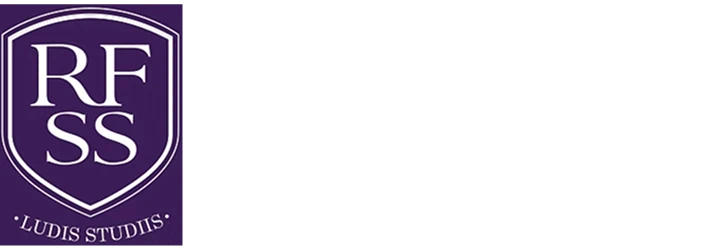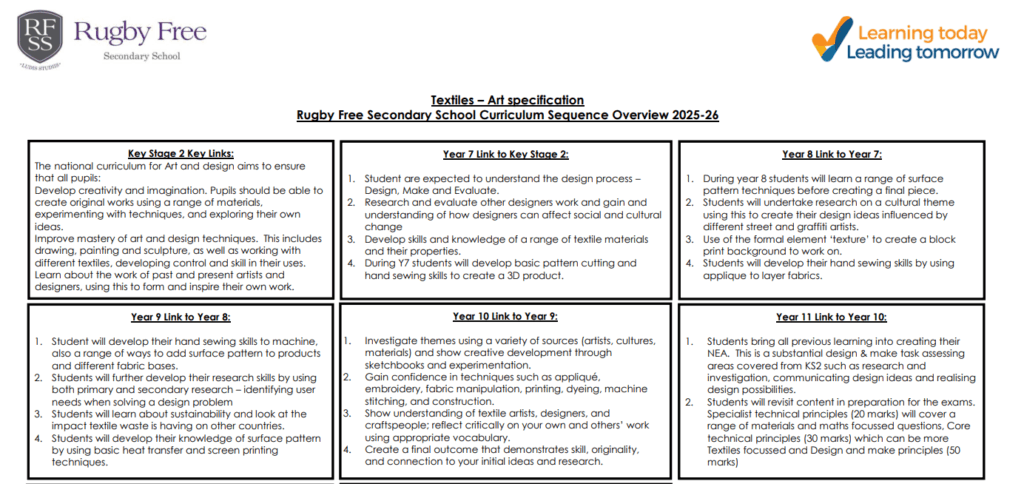At Rugby Free Secondary School, our intent for Textile Design is to inspire, challenge, and empower students to express their creativity and individuality through fabric, pattern, and mixed-media design. We aim to nurture confident, reflective, and skilled young designers who appreciate the cultural, historical, and contemporary contexts of textile art, and who can critically engage with the world around them through tactile and visual media.
Textiles is a powerful vehicle for storytelling, innovation, and identity, and we believe it fosters transferable skills such as problem-solving, resilience, visual literacy, and self-expression. Our curriculum celebrates diversity, experimentation, and the value of making by hand.
At KS3, Textile Design forms part of a broad and balanced Art and Design curriculum. The focus is on building foundational skills, developing confidence with materials and techniques, and fostering an understanding of the design process.
Through varied, hands-on projects, students gain the creative confidence and technical grounding necessary to succeed in GCSE Art Textiles.
Curriculum Aims:
Our curriculum aims to:
- Excite and ignite our pupils’ interest in textiles design and prepare them to participate in the development of a rapidly changing world.
- To ensure that learners develop technical and practical competencies as well as the wider skills valued by employers.
- To have a curriculum which will allow students to become self-motivated and confident learners, who can work independently and as part of a team.
Our broad and balanced curriculum concentrates on developing our students’ key knowledge and skills and enhances their understanding of the world around them.
Curriculum ‘How’
We do this by:
- Explore a range of textile techniques such as hand and machine stitch, applique, printmaking, fabric manipulation, and embellishment.
- Investigate the work of textile artists, craftspeople, and designers from different cultures and time periods.
- Develop design ideas through sketchbooks, mood boards, and sampling.
- Learn how to plan, create, and evaluate outcomes using the iterative design process.
- Experiment with colour, pattern, texture, and surface decoration.
- Begin to build an understanding of sustainability and the role of textiles in society and the environment.
At GCSE, students deepen their skills and develop a personal, independent approach to Textile Design as part of the AQA Art and Design specification. The curriculum enables them to produce imaginative, meaningful, and technically proficient work in response to set and self-directed themes.
- Refine their use of textile techniques and materials with increasing control and confidence.
- Explore conceptual and personal themes, responding to stimuli in thoughtful, original ways.
- Research and analyse the work of artists, designers, and craftspeople to inform their own practice.
- Develop a personal portfolio that showcases sustained investigations and a clear creative journey.
- Learn how to present and evaluate their ideas visually and verbally.
- Build resilience and independence through sustained projects, including a final externally set assignment.
The GCSE course empowers students to become articulate and thoughtful creative thinkers, prepared for further study in Art and Design, Fashion and Textiles and other creative industries.
Cultural Capital and Personal Development
Across KS3 and GCSE, our Textiles curriculum is designed to broaden horizons and develop students’ awareness of different cultures, sustainability issues, and the role of design in everyday life. It supports wellbeing by providing a therapeutic outlet for self-expression, while encouraging critical thinking, innovation, and collaboration.
Curriculum Outcome:
- Have developed a rich understanding of textile techniques and processes, with the ability to apply them purposefully and creatively.
- Be able to produce a body of practical work that reflects their ideas, interests, and influences.
- Demonstrate the ability to critically evaluate their work and the work of others using appropriate visual and technical language.
- Understand and appreciate the role of textiles in both traditional and contemporary contexts, including cultural, environmental, and commercial perspectives.
- Be equipped with the creative thinking, technical skill, and confidence to progress to further education in Art, Fashion, Design, or other creative disciplines.

